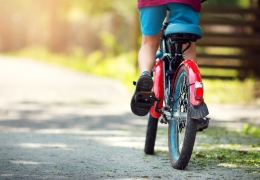30 January 2018
 As thousands of school children return to classrooms across Australia this week, leading health experts are urging parents and schools to help children become more physically active.
As thousands of school children return to classrooms across Australia this week, leading health experts are urging parents and schools to help children become more physically active.
Australian experts – including Dr Natasha Schranz, Co-Chair of Active Healthy Kids Australia (AHKA) at the University of South Australia (UniSA) - have contributed to a new report by the Australian Health Policy Collaboration (AHPC) at Victoria University which calls for all children to be supported to walk, ride or scoot at least some distance to and from school every day.
Active Travel: pathways to a healthy future urges governments at all levels to work together to enable children to be more physically active every day, by improving the physical environments around schools and by helping parents, schools and communities to support children to participate in active travel each day.
More than 70 per cent of Australia’s children and 91 per cent of young people are not meeting the national recommendation to get 60 minutes of physical activity every day. A lack of sufficient physical activity places children and young people at significant risk of developing diabetes, cancer and heart disease. It also contributes to high body weight with one quarter of all children and 29 per cent of young people being overweight or obese.
Dr Schranz says the most recent AHKA Report Card on physical activity, grades Australia a D- for overall physical activity and a C- for active transport, with only one in five children aged 5-17 years meeting the national physical activity guidelines and less than 50 per cent of school aged children using active transport (such as walking, cycling or scooting) as their usual way of getting to and from school.
“One of the easiest, economically sound and most effective ways to increase the activity levels of kids is through active transport but strong and clear leadership and commitment is required from local, state and federal governments. The policy paper today provides a clear road map for what needs to be done,” she says.
Members of AHKA Youth Advisory Council, a way to engage young Australians and give them a voice when it comes to physical activity, know the issues that need to be addressed.
“When we asked the kids themselves, members of the Council provided some clear ways to help get kids moving on their way to school like better infrastructure, safer walking and cycling routes, increased promotion of active transport and getting rid of restrictive uniforms,” Dr Schranz says.
The Active Travel: pathways to a healthy future report recommends a national infrastructure grants program to support and enable all schools, communities and local governments to address the barriers to active travel that affect individual school communities.
Director of the AHPC, Professor Rosemary Calder, says that as a nation, we have stopped moving.
“Parents think they are protecting their children from potential harm by driving them to school. This isn’t the case in the short term – children are much more likely to be injured being driven to school rather than walking or riding.
“Nationally we need to help parents and carers feel save about active travel for their children. For primary school children, setting up drop off zones some distance from each school so that children can walk independently under supervision at least some of the distance to school, would rapidly improve children’s physical activity levels.”
In November this year, UniSA with AHKA are hosting an international event ‘The Movement to Move: Global Insights to Get Our Kids Moving’ to work towards sustainable solutions to the crisis in children’s inactivity.
Media contact: Georgia Minarelli mobile: +61 413 314 726 email: Georgia.Minarelli@unisa.edu.au
Expert media contact: Dr Natasha Schranz phone: 08 8302 1285 mobile: 0403 658 592 email: Natasha.Schranz@unisa.edu.au



